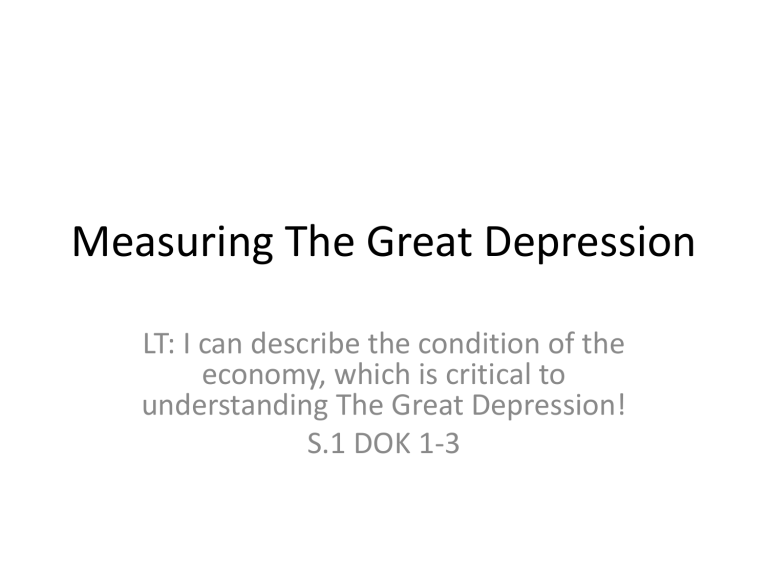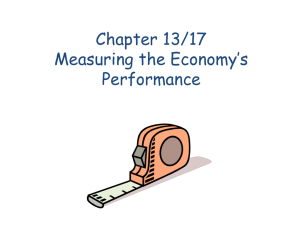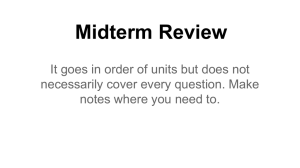Measuring The Great Depression

Measuring The Great Depression
LT: I can describe the condition of the economy, which is critical to understanding The Great Depression!
S.1 DOK 1-3
Warm Up
• Brainstorm synonyms
• Read the first four paragraphs of the Great Depression
• Why should people study the Great Depression
• Read Handout 1.1 : Notes for Measuring the Great Depression
• Divide into 7 groups
• Select a reporter
• You will be given a word
• Draw the definition on the paper by using symbols or images of the words
• You have 5 minutes to complete the task
• Group reporters explain your drawings to the class
• Discuss the process of illustrating the definitions
• Economists express these important economic concepts in numbers
• Transfer the numbers into a type of picture
• Each graph paints a picture in time, and each graph has limitations
• Use handout 1.1 to take notes
• Inflation: upward movement in the price of goods and services
• Measure the average or general tendency of price changes
• Have you ever heard your parents or grandparents talk about inflation?
• Period of inflation, if prices increase at a faster rate then peoples salaries or wages, people aren't able to buy as many goods and services
• Deflation: downward movement in the prices of goods and services in an economy
• Seemed appealing because people could buy more goods and services with their incomes then they could before
• Accompanied by falling wages and increasing unemployment
• Debtors have to repay their loans with dollars that are more valuable
• Consumers and producers who are in debt may suffer; as their incomes drop, their loan payments stay the same
• Read your statements
• As a small group decide where to place the information on the Venn Diagram
• Do a Gallery walk on your own paper and fill in your own Venn Diagram
• Milton Friedmen, Nobel Laureate economists stated, “The high price of cars doesn’t cause inflation any more than a drop in the price of hand calculators cause deflation.”
• Price stability is important to a healthy economy, price levels for the U.S. economy are measured, and there are several measures
Consumer Price Index
• Indicates monthly annual percentage changes
• Used by economists to analyze the cost of living
• Inflation or deflation year-to-year or during different historical periods
Year-to-Year percentage change
• • What information is located on the horizontal or X-axis of both graphs? (years by decade)
• • What information is located on the vertical or Y-axis of both graphs? (rate of inflation—
• i.e., the percentage change in annual price levels)
• • What does 0 percent on the vertical axis mean? (that there is no inflation or deflation—no
• change in price level from the previous year)
• • When the bar is above 0 percent, is the economy experiencing inflation or deflation?
• (inflation)
• • When the bar is below 0 percent, is the economy experiencing inflation or deflation?
• (deflation)
• • Compare the decade 1929-1939 with 1989-1999. How would you describe each decade?
• (1929-1939 appears to have volatile price level swings, which include years of inflation and
• years of deflation. 1989-1999 appears to have a high degree of price stability with low
• and stable inflation.)
• • Refer to the second graph. During the period 1929-1940, in which years did the price
• level rise relative to the previous year and during which years did the price level fall relative
• to the previous year? (rising: 1933, 1934, 1935, 1937, 1939 and 1940; falling: 1930,
• 1931, 1932, 1936 and 1938)
Gross Domestic Product (GDP)
• Use GDP data to measure the growth of the economy by comparing the change in GDP from one year to the next
• U.S. economy has grown on average about 3.0 percent to 3.5 percent annually
• “Market Value” refers to the value of goods and services in current prices\
• Only final goods and services are counted
• Only goods produced during the current year are counted as part of GDP for that year
• Within a country’s borders are counted as part of GDP
• GDP that has not been adjusted for inflation is referred to as Nominal GDP
• If Prices have risen and GDP is calculated based on current prices, the change in the size of GDP could be due to the increased prices. Economists adjust nominal GDP for inflation. GDP in terms of dollar prices of a base year . This resulting statistic is known as Real GDP
• A change in real GDP reflects an actual change in production and not a change in prices
Handout 1.3: Nominal vs. Real GDP
• Work through this handout in pairs
• Review answers with class
• Real Gross Domestic Product ( Real GDP)
• Example of real GDP data displayed pictorially as a line graph
Questions
• What information is shown on the x-axes of both graphs?
• What does the trend (dotted) line on the graph indicate?
• What period in history is most noticeably below trend in
GDP?
• What does this suggest happened during that time?
• Look at the second graph on the page
• This bar graph shows GDP growth from 1928 through 1940, which are the years for which GDP was most below trend on the first graph
• GDP growth was below trend
• During what years was GDP the lowest?
Visual 1.6 Civilian Unemployment Rate
• Civilian unemployment rates from 1919-2006
• Unemployment rate represents the number of unemployed as a percentage of the labor force, and an annual unemployment rate is reported monthly by the Department of
Labor’s Bureau of Labor Statistics
• Unemployed do not have jobs, actively looking for work and currently available for work
Questions for 1.6
• What information is shown on the X and Y axes of both graphs?
• During what years did the economy experience the lowest rates of unemployment?
• What events were occurring from 1943-1945?
• Why would unemployment be lowest at this time?
• During what year did the economy experience the highest rate of unemployment?
• What was the rate?
Questions Handout 1.1 Visual 1.3
• What happened to the CPI between 1929-
1939?
• Does this mean that the economy on average was experiencing inflation or deflation?
Question Visual 1.5
• What happened to Real GDP between 1929-
1939?
Questions visual 1.6
• What happened to unemployment between
1929-1933?
• When did the unemployment rate return to its pre-1929 value?
Depression
• A period of severely declining economic activity spread across the economy normally visible in a decline in real GDP, real income, employment, industrial production, wholesale-retail credit and the loss of overall confidence in the economy.
• 25 percent unemployment
• Prices falling
• Reductions in incomes and contribute to rising unemployment
• GDP means that not as many goods and services are being produced
Exit
• Why after all this time, people still study the Great
Depression?
• What is inflation?
• What is deflation?
• What is the CPI?
• What was happening to the price level during the Great
Depression?
• What is the unemployment rate?
• What was happening to unemployment during the Great
Depression?
• What is Gross Domestic Product?
• What was happening to GDP during the Great Depression?
Assessment
• Handout 1.5: Political Cartoon
• Handout 1.6: What is in the Chairman’s
Briefcase?











